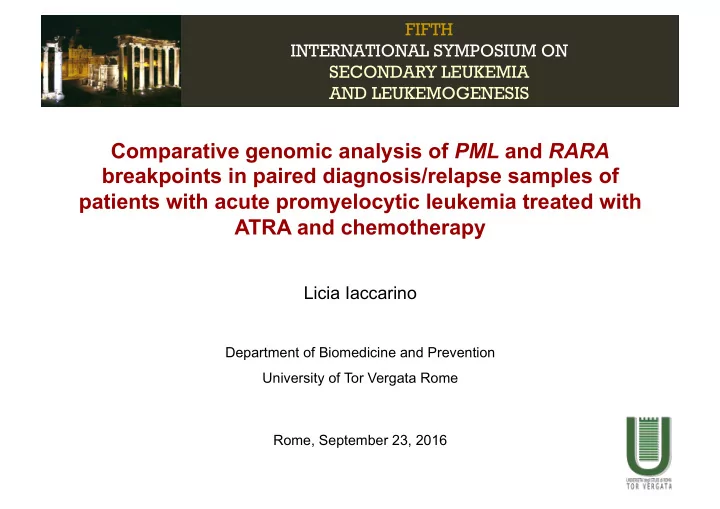

FIFTH INTERNATIONAL SYMPOSIUM ON SECONDARY LEUKEMIA AND LEUKEMOGENESIS Comparative genomic analysis of PML and RARA breakpoints in paired diagnosis/relapse samples of patients with acute promyelocytic leukemia treated with ATRA and chemotherapy Licia Iaccarino Department of Biomedicine and Prevention University of Tor Vergata Rome Rome, September 23, 2016
ü “Therapy-related” acute promyelocytic leukemia has been Autoimmune diseases reported in cancer patients treated with: Multiple sclerosis Inflammatory Rheumatoid - Topoisomerase II inhibitors bowel disease arthritis - Radiation therapy ü t-APL has been reported in patients who received Primary neoplasms before t-APL chemotherapy for a non-malignant disorder . Breast cancer Tumors of the Non Hodgkin genitourinary system lymphoma
Molecular insights in therapy-related APL Breast cancer and Multiple sclerosis multiple sclerosis 6 t-APL arising after mitoxantrone 12 t-APL arising after mitoxantrone
Clustered distribution of genomic breakpoints in PML
Topoisomerase II inhibitors Two main classes: 1. Catalytic inhibitors: Anthracylines (epirubicin and daunorubicin) 2. TOPO-IIA poisons: Etoposide and Mitoxantrone
t-MN can develop after first-line treatment for APL 918 de novo APL patients treated with ATRA + anthracycline-based CHT 17 patients developed a t-MN (MDS, AML, ALL), after a median of 43 months from CR. The 6-year cumulative incidence of t-MN was 2.2% Despite t-MN is relatively infrequent after first-line treatment of APL with ATRA and standard CHT, therapeutic strategies to avoid / minimize this severe complication are warranted.
Topo-II inhibitors and APL development The incidence of t-APL after mitoxantrone in multiple sclerosis is 2%. The rate of relapse of APL is ~10% after combined ATRA + anthracycline-based chemotherapy.
Hypothesis Disease Recurrence in APL Therapy related APL or true relapse? Investigate possible switches of breakpoints in PML and/or RARA between diagnosis and relapse with potential involvement of therapy-related “hotspot” regions at “relapse”
Methods • 30 APL paired diagnosis/relapse cases with available DNA • Identification of PML/RARA isoforms • Long-range PCR to amplify the genomic PML/RARA rearrangement • Direct sequencing to identify the exact location of the breakpoint
Clinical characteristics of APL patients (n=30) Median age (range) 36 years (5-77 years) Sex (M/F) 16/14 LPA99 (n=4) AIDA2000 (n=16) Treatment IC-APL (n=3) ICC-APL01 (n=2) MRC (n=5) Mitoxantrone (total median 90 mg (20-90 mg) dose) Anthracyclines (total median 144 mg (51-756 mg) dose) Median latency (range)* 19 months (5-105 months) * Latency between APL diagnosis and relapse
Primer positioning for long-range PCR PML PML/RARA RARA bcr3 bcr2 bcr1 Intron 2 Exon 3 E 1 2 3 4 5 6 2 1 1 2 3 4 5 6 7 8 Forward primers Reverse primers 16.9kb Chromatogram obtained revealing the breakpoint junction sequence Mistry et al, NEJM 2005; Hasan et al, Blood 2008
Results: distribution of PML/RARA breakpoints 8 bp ‘’hotspot’’ region APL patient 100 2000 100 2000 1966 bp 2094 bp PML _BCR1 region PML _BCR3 region 400 16700 16.9 kb RARA intron 2 The location of the breakpoint was in all cases identical at diagnosis and at relapse
Conclusions • The molecular profile of the breakpoints at the t(15;17) translocation was identical at diagnosis and relapse in 30 analysed pts • PML breakpoints were never localized within the hotspot region at position 1482-1489, previously identified in t-APL developing after mitoxantrone treatment • Considering the rarity of APL relapse, a larger series of patients analysed at diagnosis and relapse are needed to better investigate whether a “relapse” may mask t-APL.
Acknowledgements Tiziana Ottone David Grimwade Syed Khizer Hasan Giuseppe Basso Mariadomenica Divona Esperanza Such Laura Cicconi Monica Boccia Serena Lavorgna Eduardo Magalhaes Rego Valentina Alfonso Claudia Ciardi Adriano Venditti Sergio Amadori Maria Teresa Voso Francesco Lo-Coco
Recommend
More recommend